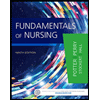Ms. Jackson is a single, 56-year-old woman with a 20-year history of type 1 diabetes, hypertension, hyperlipidemia, chronic anemia, and a total knee replacement. She has been diagnosed with CKD. She was admitted to a medical unit for treatment of shortness of breath and CKD. Treatment will include hemodialysis. She has had increasing shortness of breath, has pitting edema, urine output of about 375 mL/day, and is having premature ventricular contractions (PVCs) as seen on the cardiac monitor. Her admitting laboratory values are Na 131, K 6, Cl 97, Ca 10, iron (Fe) 64, WBC 4000, RBC 3.12, Hgb 10.1, Hct 32, creatinine 7, BUN 30. Her blood glucose levels yesterday were as follows: 07:00, 154 mg/dL; noon, 122 mg/dL; 17:00, 188 mg/dL. She has sliding-scale insulin ordered. She is having an echocardiogram and chest x-ray done. She is having a two-tailed subclavian catheter placed for blood access. She is withdrawn and quiet. 1. What would be the first thing the nurse would address after getting the report? 2. What do Ms. Jackson’s physical symptoms indicate and the laboratory values reflect? 3. What should the nurse say to Ms. Jackson in relation to her withdrawn behavior? 4. What should the nurse identify related to Ms. Jackson’s understanding of self-care? 5. What teaching is needed for the diagnostic tests?
Ms. Jackson is a single, 56-year-old woman with a 20-year history of type 1 diabetes, hypertension, hyperlipidemia, chronic anemia, and a total knee replacement. She has been diagnosed with CKD. She was admitted to a medical unit for treatment of shortness of breath and CKD. Treatment will include hemodialysis. She has had increasing shortness of breath, has pitting edema, urine output of about 375 mL/day, and is having premature ventricular contractions (PVCs) as seen on the cardiac monitor. Her admitting laboratory values are Na 131, K 6, Cl 97, Ca 10, iron (Fe) 64, WBC 4000, RBC 3.12, Hgb 10.1, Hct 32, creatinine 7, BUN 30. Her blood glucose levels yesterday were as follows: 07:00, 154 mg/dL; noon, 122 mg/dL; 17:00, 188 mg/dL. She has sliding-scale insulin ordered. She is having an echocardiogram and chest x-ray done. She is having a two-tailed subclavian catheter placed for blood access. She is withdrawn and quiet.
Ms. Jackson is a single, 56-year-old woman with a 20-year history of type 1 diabetes, hypertension, hyperlipidemia, chronic anemia, and a total knee replacement. She has been diagnosed with CKD. She was admitted to a medical unit for treatment of shortness of breath and CKD. Treatment will include hemodialysis. She has had increasing shortness of breath, has pitting edema, urine output of about 375 mL/day, and is having premature ventricular contractions (PVCs) as seen on the cardiac monitor. Her admitting laboratory values are Na 131, K 6, Cl 97, Ca 10, iron (Fe) 64, WBC 4000, RBC 3.12, Hgb 10.1, Hct 32, creatinine 7, BUN 30. Her blood glucose levels yesterday were as follows: 07:00, 154 mg/dL; noon, 122 mg/dL; 17:00, 188 mg/dL. She has sliding-scale insulin ordered. She is having an echocardiogram and chest x-ray done. She is having a two-tailed subclavian catheter placed for blood access. She is withdrawn and quiet.
1. What would be the first thing the nurse would address after getting the report?
2. What do Ms. Jackson’s physical symptoms indicate and the laboratory values reflect?
3. What should the nurse say to Ms. Jackson in relation to her withdrawn behavior?
4. What should the nurse identify related to Ms. Jackson’s understanding of self-care?
5. What teaching is needed for the diagnostic tests?
6. What nursing care is required for the blood access?
7. What type of insulin is used for sliding-scale insulin coverage? Why?
8. With what members of the health team would the nurse anticipate co
Trending now
This is a popular solution!
Step by step
Solved in 7 steps









